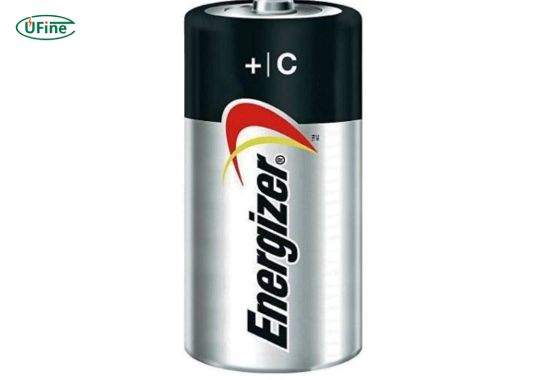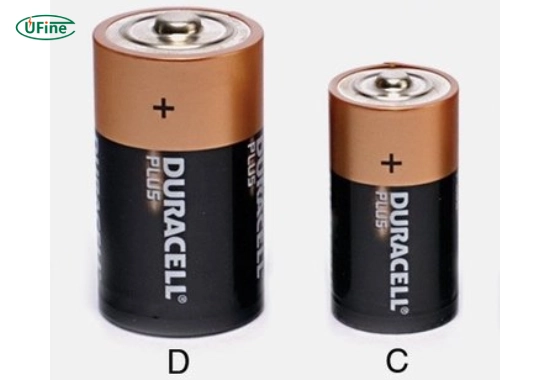Batteries are everywhere in our daily lives. They power our flashlights, radios, toys, and many other devices. But when choosing a battery, you might wonder about the differences between D and C batteries.
What is the difference between a D battery and a C battery?
The main differences are size, capacity, and power output. D batteries are more significant, store more energy, and last longer. C batteries are smaller and work well in medium-power devices.
Choosing the correct battery is essential. Using the wrong type can lead to shorter battery life, weaker performance, or even damage your device.
In this guide, we will compare D batteries vs. C batteries in detail. We will explore their features, uses, advantages, and how to choose the right one for your needs.
Part 1. What is a D battery?
A D battery is a large, cylindrical battery used in devices that require strong, steady power for a long time.
Key features of D batteries
- Size: 61.5mm height, 33.2mm diameter
- Voltage: 1.5V (alkaline) or 1.2V (rechargeable NiMH)
- Capacity: 12,000–20,000 mAh (depends on type and brand)
- Weight: Around 140–160 grams
- Common uses: Large flashlights, radios, medical devices, and some toys
D batteries have large energy storage and can run high-drain devices for long periods.
Different types of D batteries
There are different types of D batteries, including:
- Alkaline D batteries: The most common type. They are affordable, reliable, and disposable.
- Rechargeable D batteries: These can be recharged and reused, saving money in the long run.
- Lithium D batteries: These last longer than alkaline batteries but cost more.
Part 2. What is a C battery?
A C battery is a medium-sized cylindrical battery used in everyday devices that need steady but moderate power.
Key features of C batteries
- Size: 50mm height, 26.2mm diameter
- Voltage: 1.5V (alkaline) or 1.2V (rechargeable NiMH)
- Capacity: 6,000–8,000 mAh
- Weight: Around 65–75 grams
- Common uses: Small flashlights, musical instruments, radios, and children’s toys
C batteries are a balance between compact size and decent power output.
Different types of C batteries
- Alkaline C batteries: The most common type. They are cheap and disposable.
- Rechargeable C batteries: Eco-friendly and cost-effective over time.
- Lithium C batteries: Longer-lasting but more expensive.
Part 3. What are the main differences between D and C batteries?
- Size and dimensions
D batteries are more significant than C batteries. A D battery is about 61.5mm in height and 33.2mm in diameter, while a C battery is 50mm in height and 26.2mm in diameter. - Capacity and power output
D batteries have a higher capacity (12,000–20,000 mAh) than C batteries (6,000–8,000 mAh), which means they last longer in high-drain devices. - Weight
D batteries are heavier because they contain more active material. C batteries are lighter, making them more suitable for portable gadgets. - Usage and applications
Use D batteries for high-drain devices (e.g., large flashlights, radios, and medical devices).
Use C batteries for medium-drain devices (e.g., toys, musical instruments, and small flashlights).
Part 4. Can you use C batteries instead of D batteries?
Yes, but with limitations.
An adapter can fit a C battery inside a D battery slot, but it has a lower capacity. This means the device may run out of power much faster than a D battery.
If your device requires high power, it is not recommended to use a C battery instead of a D battery because the former will not last as long.
Part 5. Which battery lasts longer: D or C?
D batteries last longer than C because they have more energy storage (higher mAh capacity).
For example:
- A D battery can last 20+ hours in a high-drain flashlight.
- A C battery in the same flashlight may last only 10–12 hours.
If battery life is essential, D batteries are the better choice.
Part 6. Are D and C batteries interchangeable?
D and C batteries are not directly interchangeable because of their size and capacity differences.
- If your device requires D batteries, using C batteries will result in shorter battery life.
- If your device requires C batteries, D batteries won’t fit unless modified.
- Some battery adapters allow C batteries in D battery slots, but performance may be reduced.
Part 7. Are there rechargeable D and C batteries?
Yes! D and C batteries come in rechargeable versions, usually NiMH (Nickel-Metal Hydride) or Lithium-ion.
Benefits of rechargeable batteries:
- Cost savings: Rechargeable batteries can be reused hundreds of times.
- Eco-friendly: Less battery waste reduces pollution.
- Consistent power: Rechargeable batteries provide a stable voltage output.
Rechargeable D or C batteries are a significant investment if you use devices requiring frequent battery changes.
Part 8. Which battery is best for your needs?
Choose D batteries if:
- ✔ You need long-lasting power
- ✔ You use high-drain devices
- ✔ You require larger batteries for durability
Choose C batteries if:
- ✔ You need a compact, medium-power battery
- ✔ You use small to medium-drain devices
- ✔ You prefer a lighter battery for portability
Part 9. Cost comparison: D battery vs. C battery
D batteries are more expensive than C batteries because they have higher capacity and more materials.
| Battery Type | Average Price (Per Battery) | Lifespan in High-Drain Devices |
|---|---|---|
| D Battery | $2.50 – $5.00 | 20+ hours |
| C Battery | $1.50 – $3.50 | 10–12 hours |
D batteries are worth the investment if your device needs high power for a long time.
Part 10. FAQs
Can I use a D battery in place of a C battery?
No, a D battery is too large to fit in a C battery slot. If size is not an issue, a D battery would last longer than a C battery.
Why do D batteries last longer than C batteries?
D batteries have a higher capacity (mAh), storing more energy and last longer in high-power devices.
Are D batteries more powerful than C batteries?
Yes, D batteries can deliver power for a longer time than C batteries due to their larger size and higher capacity.
Can I recharge both D and C batteries?
Yes! Rechargeable D and C batteries are available, usually in NiMH or Lithium-ion types.
What happens if I use the wrong battery size in my device?
Using the wrong battery size can result in shorter battery life, improper fit, or even damage to the device. Always use the correct battery type recommended by the manufacturer.
Related Tags:
More Articles

How to Choose the Best Floor Scrubber Battery for Commercial Cleaning?
Selecting the ideal floor scrubber battery ensures a long runtime, rapid charging, and minimal maintenance for efficient commercial cleaning operations.
Battery for Blower vs Battery for Leaf Vacuum: Which One Should You Choose?
Battery for blower vs leaf vacuum—learn the key differences in power, fit, and runtime to choose the right battery for your outdoor tool needs.
How to Choose the Right Battery for Blower?
Choosing the right blower battery? Consider voltage, capacity, chemistry & usage. This guide helps match the best battery for peak performance.
How to Choose the Best Insulated Battery Box for Lithium Batteries?
Choosing the Best Insulated Battery Box for Lithium Batteries? Discover key factors such as size, material, and safety for optimal protection and performance.
7 Critical Elements on a Lithium Battery Shipping Label
What must be on a lithium battery shipping label? Learn 7 key elements to ensure safety, legal compliance, and correct handling across all transport modes.






